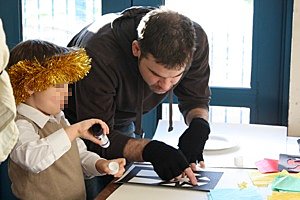 It has been two years since the congregation formerly known as St Luke’s in Somerstown (in the heart of Portsmouth) moved out of its building and began gathering instead in one of the nearby tower blocks. On Advent Sunday in 2009, with the Bishop’s permission, we ceased Sunday services and opened instead what we have called the Sunday Sanctuary. This wasn’t simply the relocation of our services to another place. We went right back to almost nothing. We had breakfast together and invited residents of the tower block (mainly young families) to join us. We imagined that the typical encounter would involve a bite to eat, a chat and maybe something a bit hands on and – with a light touch – spiritual. Maybe people would stop for 20 minutes or so.
It has been two years since the congregation formerly known as St Luke’s in Somerstown (in the heart of Portsmouth) moved out of its building and began gathering instead in one of the nearby tower blocks. On Advent Sunday in 2009, with the Bishop’s permission, we ceased Sunday services and opened instead what we have called the Sunday Sanctuary. This wasn’t simply the relocation of our services to another place. We went right back to almost nothing. We had breakfast together and invited residents of the tower block (mainly young families) to join us. We imagined that the typical encounter would involve a bite to eat, a chat and maybe something a bit hands on and – with a light touch – spiritual. Maybe people would stop for 20 minutes or so.
We had no idea whether anyone would come. But come they did. And those who came did not come for a brief visit. They came in the moment we opened the doors each week, stayed with us all morning and before long, unbidden, got stuck in with clearing up at the end of the morning. This very different sort of engagement than we had imagined meant we very quickly had to give the morning more structure and shape. It threw us back on the liturgy. What we do together now has the skeleton of an Anglican Eucharist – we gather over breakfast; we set aside all that we regret from the past week; we collect our thoughts and prayers; we share a story and reflect together on its meaning for us today; we look out to the needs of those around us and the wider world; we give thanks; we share bread and grape juice and we ask God’s blessing as we go on. Though the flesh on the bones might not be so immediately familiar, there is a family resemblance with our sister churches in the Church of England.
As I reflect on the past two years, and what we’ve learnt together, I am bound to ask: has it been a success?
That, of course, depends on what you mean by success. I think we set out on this journey with a little bit of a Field of Dreams mentality: ‘if you build it, they will come’. (That’s a misquote I know but I hope you’ll excuse a little creative license there.) I think we set out with the idea that if we changed what we do together; changed where we do it and changed who we invited to come, that we would make some sort of breakthrough in Somerstown and in particular in the block of flats (Wilmcote House) to which we had relocated.
In those terms, the Sunday Sanctuary has failed.
We have failed to make a big breakthrough in Wilmcote House or in Somerstown. We have engaged with a small number of families in the block, some who have stayed with us and others who have moved on after a little while. But most of the young families in the block pretty much ignore us.
Maybe our ‘offer’ is wrong. We insist on children coming with at least one grown up. We are running a family gathering in a place and at a time when a significant number of parents just want their kids out of the way or off their hands. We had a suspicion from the outset that a kids’ club would be overwhelmed. We had neither the people nor the resources to sustain something like that. So we set ourselves the parameter of barring unaccompanied primary- and pre-school age children at the very beginning. That has proved very difficult at times. I have hated having to turn away kids that are desperate to come in.
But even more fundamentally, I think, the biggest flaw in our thinking is that we were still ultimately operating an attractional model of mission. We were still creating an event that we expected people to come to. We made it as easy as possible for people to come – especially by moving ourselves much closer to where they live. But it still relies on people responding to an invitation from strangers to come to an event they know little about.
So though we took a massive step out of our comfort zone, I still don’t think we fully inhabited Jesus’s radical sending of his disciples to be guests, reliant on the hospitality of others in hostile territory.
As an initiative, then, in terms of measurable outcomes, it has failed.
But what a beautiful failure.
I write this a couple of days after we baptised five members of our community. Of those (four children and one adult), only one came from a family that I think would have explicitly defined themselves as Christians a couple of years ago. And as I write this I am looking forward to seeing six more members of our community confirmed at the cathedral. People whose connection to Christian faith has been very basic and tenuous have discovered a lively faith for themselves.
We have grown in numbers in a small way. We’ve also lost some more longstanding Christians. Some were not able to cope with being so far out of their comfort. Others have simply relocated. So we are not much bigger.
That is so often the measure by which people – consciously or otherwise – judge whether something has been a success. I hinted at it myself earlier by talking about a ‘big’ breakthrough. And on those terms, we have just about stayed steady. We have failed to achieve numerical growth.
But our growth in depth has been marked. Those longstanding Christians who have been able to stick with it have grown in faith as they’ve engaged with new people in an unfamiliar setting. Newer members who had only the most nominal faith have reached a point where they are making a public commitment to live as a Christian. We’ve all grown in the breadth of our spiritual experience as we’ve moved closer to becoming united with our sister parish of St Peter’s.
But above all we’ve grown in the depth of our relationships. The newer members aren’t people who’ve joined us any longer. They are us. We have become one family.
There are lots of things we’ve learnt through this whole experience.
First, I think we’ve been reminded of something we already knew, even explicitly remarked upon. People in this place don’t come to stuff. It’s not a matter of tweaking our event to get it just right and then people will come. They won’t. They’re not interested. They don’t care what we have to say. Maybe we could cast our net a bit wider (leaflet all the tower blocks instead of just one) and maybe we’d get one or two more families like the lovely ones who found their way to us and became part of us. We will probably do that. But the fundamental and stark reality still holds. If we build it, they will not come.
Second, we can’t look to the handful of local families who are part of our community to reach their neighbours all by themselves. That’s because they are not the hard to reach, troubled families. Those who have joined us are really nice, together people. If that sounds judgemental on the rest of the families around, I’m sorry. But most of us know what we mean by ‘nice’ people. These are they. Sunday Sanctuary really was a sanctuary for them from the troubles and menace around them. It would take incredible courage, confidence and faith for these brand new Christians to reach out to the most challenging of their neighbours.
Third, that means this is no ‘hit and run’ sort of ministry for me. The idea I started out with that I could spend about three years here and, during that time, get something off the ground, train up local leaders and then move on to the next place (I really thought this!) – well that just seems laughable now. I am going to have to be here for the long haul.
Finally what has dropped like a great big penny is that ministry here has to be relational. Again, I’ve said that before. Right at the outset. But I’m only just beginning to understand what that means. What we’ve discovered, because this is what’s actually happened, is that if we’re going to make a difference in Somerstown, it will be one family at a time. It will be about investing in real friendship – giving time, attention, love and practical support to a small number of people at any one time. It’s like the old story of the little boy throwing starfish back into the sea after a storm. The beach is covered in starfish as far as the eye can see. A man says to the boy: ‘how on earth do you hope to make any difference?’ Picking up another starfish, and casting it back into the safety of the sea, the boy says, ‘made a difference to that one.’



















 One reader posted a question today as a comment on the previous post, asking if it is ‘all quiet on the Western Front’. It has always been a feature of blogs that bloggers write a lot of posts apologising for not writing posts. I’m no exception. It has been quiet on this blog and I do worry that I will be annoying or alienating those people who take the time and trouble to read it. Sorry. I had a really interesting comment from ‘Ferry’ in questions of power and identity to which I’m still formulating a response.
One reader posted a question today as a comment on the previous post, asking if it is ‘all quiet on the Western Front’. It has always been a feature of blogs that bloggers write a lot of posts apologising for not writing posts. I’m no exception. It has been quiet on this blog and I do worry that I will be annoying or alienating those people who take the time and trouble to read it. Sorry. I had a really interesting comment from ‘Ferry’ in questions of power and identity to which I’m still formulating a response. It was a bit longer than a week or so wasn’t it! It’s been a busy summer with a real variety of experiences. And now I am looking down the barrel of a very challenging autumn.
It was a bit longer than a week or so wasn’t it! It’s been a busy summer with a real variety of experiences. And now I am looking down the barrel of a very challenging autumn.
Recent Comments